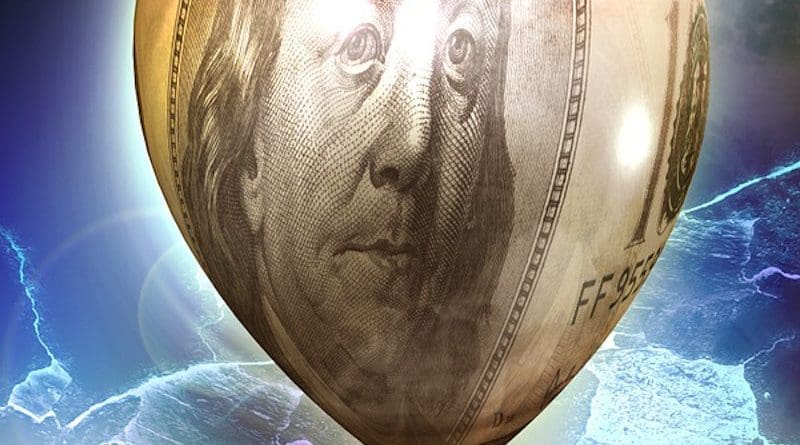Attack Of The Inflation Hawks – OpEd
By Dean Baker
Last month the Federal Reserve Board’s Open Market Committee (FOMC) voted 7 to 3 to commit itself to keep its short-term interest rate at near zero for the next two years. Given the persistence and severity of the downturn, this was a modest step for the Fed to take to boost the economy.
There were several more aggressive actions that the Fed could have taken. For example, the Fed could have targeted a longer-term interest rate. This could mean something like setting a 1.0 percent interest rate target for five-year Treasury bonds over the next year. Such a policy could be expected to drive down borrowing costs throughout the economy. That would lead to more mortgage refinancing and some additional investment.
Lower interest rates would likely also lead to a somewhat lower value of the dollar. This would make imports more expensive and make our exports cheaper to people living in other countries. That should help to reduce our trade deficit, the most important imbalance facing the economy.
The Fed could have also been even more aggressive and followed a path suggested by Ben Bernanke for Japan’s central bank back when he was still a professor at Princeton. Bernanke recommended that Japan’s central bank deliberately target a higher inflation rate in the range of 3-4 percent. This would have the effect of reducing real interest rates when short-term nominal rates are already at zero. It would also reduce the burden of debtors.
Alternatively, the Fed could have just done more of the same. It could have followed up its second round of quantitative easing (QE), with another round of bond buying. The idea is to push up the price of Treasury bonds and thereby lower interest rates. While there is some dispute about the impact of the prior two rounds of QE, there is reason to believe that they had at least some positive effect.
However, the three dissenters did not want the Fed to pursue any of these paths. They were uncomfortable even with a statement that the Fed would continue to keep its short-term rate near zero. This is in spite of the fact that the unemployment rate remains over 9.0 percent and growth has averaged less than 1.0 percent over the last six months.
The dissenters were worried about inflation. The concern about inflation seems positively bizarre for an economy with such high unemployment and so much excess capacity. Workers have almost no bargaining power. They are lucky if their wages just keep pace with inflation; they have little hope of wage increases that are in line with productivity growth.
The core inflation rate continues to hover just under 2.0 percent. It has remained pretty much constant since the start of the downturn.
The inflation hawks can point to a rise in the overall rate of inflation, but this was driven by surges in food and energy prices. These were in turn partially attributable to speculation and partly due to rapid growth in China and other developing countries. The speculative part of this run-up looks like it is being reversed as some commodity prices, most notably oil, have fallen sharply in recent months. The Fed really can’t hope to do much about rises in commodity prices that are driven by rapid growth in the developing world.
This raises the question of why the hawks are so concerned about a seemingly non-existent inflation threat. It is worth noting that all three of the dissenting votes were Fed district bank presidents. The presidents of the Fed’s 12 district banks all sit on the FOMC, with five of them voting at any one time. Three of the five bank presidents voted against any action to spur growth.
The bank presidents essentially represent the banks within their district. Banks tend to be very concerned about inflation since it erodes the value of their loans. They tend to be less concerned about unemployment, probably because the bankers have jobs, as do most of their friends.
While the bank presidents voted three-to-two against taking any action to boost the economy, the five governors voted unanimously in support of the statement committing the Fed to keep its short-term rate at zero for the next two years. In contrast to the bank presidents, the governors are appointed through the political process. Interestingly there was no partisan divide on this vote. Three of the governors were appointed by President Obama, one by President Bush, and one (Chairman Bernanke) by both. Yet all five felt that the Fed’s mandate to promote full employment required stronger action.
The sharp split between the FOMC members appointed by the banks and the members appointed through the political process is very disturbing. It suggests that the financial industry is using an agency of the government (the Fed) to advance its own interests.
While industry capture is a problem with all regulatory bodies, in no other case does the industry directly appoint members to the body. Comcast and General Electric have to lobby the Federal Communications Commission (FCC); they don’t get their own votes on the FCC.
There is no reason that the banks should get the special privilege of being assigned seats on the Fed, the most powerful regulatory agency of them all. There is no place in a democracy for the bankers’ direct role in setting Fed policy. The banks should have to buy their influence just like everyone else.
This article was originally published on Al Jazeera and reprinted with the author’s permission

